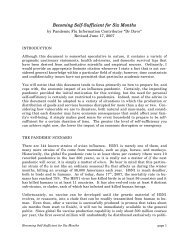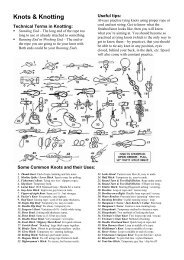You also want an ePaper? Increase the reach of your titles
YUMPU automatically turns print PDFs into web optimized ePapers that Google loves.
THE FOOLPROOF FOUR<br />
stem is not found in all puffballs. If a definite and distinct stem<br />
runs through such a section from bottom to top, the plant is not a<br />
puffball!<br />
Puffballs can be found in open, grassy meadows and parks and<br />
among hardwood trees and brush. They occur all through the<br />
growing season but are likely to be far more abundant in the fall.<br />
Like many other kinds of mushrooms they come up in the same<br />
place year after year, and when sliced and fried in butter they have<br />
few rivals. The only simple precautions to be observed are, first, to<br />
examine the interior closely for evidence of tiny worms, which<br />
may infest the base and work up through the body of the puffball,<br />
rendering it unfit for food; and, second, to eat only those that are<br />
firm and white inside. Once the interior begins to turn yellow the<br />
puffball is not desirable for food, although by no means poisonous.<br />
Sulphur Shelf <strong>Mushrooms</strong>, or Sulphur Polypores<br />
These mushrooms (Figure 4) belong to the general group of<br />
wood-inhabiting shelf fungi. They grow on old rotten logs and<br />
on standing trees, both living and dead. Oaks are their favorite host,<br />
but they are found on a large variety of other trees as well and are<br />
common throughout the country.<br />
On fallen logs the sulphur polypore forms colorful orange and<br />
yellow rosettes of many overlapping, fan-shaped shelves. On standing<br />
trees the shelves appear one above the other, often for a distance<br />
of several feet up and down the trunk. Clumps weighing several<br />
pounds are not uncommon. The shelves extend from 4 to 10 inches<br />
outward from the point where the base is attached to the wood.<br />
In fresh specimens the upper surface is zoned with yellow and<br />
bright golden orange and the lower surface is bright yellow, but<br />
upon exposure to weather the upper surface gradually fades to a<br />
more or less uniform pale yellow. The lower surface is composed<br />
of a layer of fine pores, whence the name polypore.<br />
The sulphur polypore is to be sought in the fall wherever old<br />
decaying trees abound. The shape and color make it impossible to<br />
21
















